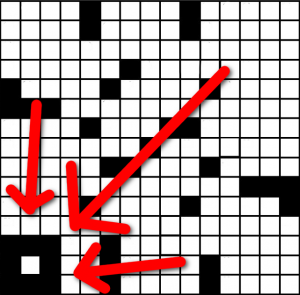Dear Sir,
Thank you for your submission to the New York Times daily crossword. Every week we receive hundreds of outstanding puzzle submissions and we wish that we could publish them all. Unfortunately, we regret to inform you that, at this time, we will be unable to publish your most recent submission, a crossword puzzle that you’ve titled “The One Thing I’m Afraid Of.”
This decision was based on several key factors:
First off, although the NYT crossword is known for the exacting difficulty of its clues, we here at the Times were worried that some of your answers were both inordinately difficult and extraordinarily subjective. Usually, the solution to a crossword clue should be something in the public vernacular, something like “TACO” or “BOOMERANG.”
Meanwhile, in your puzzle you had clues such as:
- 2 down — An emotion I’m currently experiencing.
- 30 across — My greatest fear.
- 74 across — The place I dare not go.
According to your submission, the answers to these clues should be, respectively, “FEAR,” “THE SHADOW MAN” and “MY DREAMS.” However, at the risk of being overly blunt, I believe that these answers would be exceedingly difficult for any one person to solve on their own.
Another quibble I had with your submission is that, preferably, you should not repeat any of your answers. For example, if a crossword used the word “OREO” as a solution, it would (hopefully) only use that answer once.
Sadly, you have used the same exact answer an unprecedented four different times. Consider for a moment your puzzle’s following clues:
- 3 down — His name.
- 15 across — The name of my fear.
- 50 down — The shadow-man who found me in my dreams and compelled me to make this crossword puzzle so that the world would, at long last, know his name and fear it.
- 57 across — His NAME!
Sir, in an ideal world, these clues would each have four different, discrete answers. However, in your puzzle, the solution to all four of these clues is, confoundingly, the same exact phrase — more specifically, the name “Harrison Chafitz.”
Now, I personally have never heard of a man called “Harrison Chafitz” before. And neither have any of my extraordinarily qualified colleagues here at the Times, but either way it would still undoubtedly benefit you not to repeat this solution (i.e. “Harrison Chafitz”) with such regularity.
Indeed, dear sir, who is Harrison Chafitz? Why is he so important? And why (why?) have you dedicated an entire crossword puzzle to a quote-unquote “Shadow Man” — a fictitious dream-walker who does not (and, it should be noted, cannot) exist?
As a reader, these were just a few of the many questions your puzzle caused me to ask.
Finally (and this is a very small complaint), while looking over your submission, one of your clues struck me as particularly problematic. Obviously, we here at the Times are unopposed to including, how shall we say, non-traditional answers within our puzzles. For example, the clue “ABC, easy as ___” would have the non-alphabetic answer “123.”
But with that in mind, I would now like you to consider one of the clues you wrote in your puzzle. You wrote:
- 62 down — Draw his face. Draw his face. Draw the face of Harrison Chafitz. Draw it. Draw it now.
This clue is clearly problematic for several key reasons. Not only does it explicitly reveal the answer to your puzzle’s four longest clues (as mentioned above, the name “Harrison Chafitz” appears four times). But, more importantly, this specific clue relies on your audience’s ability to, ostensibly, draw a scale model of a man’s face within a single crossword square — a feat that most would consider to be difficult, nigh impossible.
In addition (and again, this is very small complaint), but this particular clue does not seem to be related in the slightest to the rest of your puzzle. Especially given that it is enclosed within its own, individual border (see below):
For reference, here is the clue in question:
Making a crossword puzzle is no small feat. And we here at the Times commend your ingenuity and unconventional élan. But regrettably, for all these reasons (and many, many more), we will be unable to run your puzzle within the pages of our lauded publication.
All the best,
Will Shortz, Puzzle Editor of the New York Times
P.S. If you’re still looking for a publisher, please do try sending your puzzle off to the good folks at the L.A. Times. Those guys’ll publish anything.



